Invented by Paul Harry Gleichauf, ARM Ltd
Blockchain mining is the process of validating and verifying transactions on a blockchain network. It involves solving complex mathematical problems to add new blocks to the chain and ensure the integrity of the network. Traditionally, mining has been done by individual miners or mining pools, where multiple miners combine their computing power to increase their chances of solving the problem and earning rewards.
However, with the increasing complexity of mining operations and the need for more secure networks, the concept of trusted nodes has emerged. Trusted nodes are nodes that have been vetted and approved by the blockchain network to participate in the mining process. These nodes are typically operated by reputable organizations or institutions that have a vested interest in maintaining the integrity and security of the network.
The market for blockchain mining using trusted nodes offers several advantages over traditional mining operations. Firstly, trusted nodes provide a higher level of security and reliability. Since these nodes have been vetted and approved by the network, there is a lower risk of malicious actors infiltrating the mining process and compromising the network’s security.
Secondly, trusted nodes often have access to more advanced and powerful computing resources, which can significantly increase the efficiency and speed of the mining process. This can result in faster transaction confirmations and a more seamless user experience.
Furthermore, the use of trusted nodes can help address some of the environmental concerns associated with traditional mining operations. The energy consumption required for mining cryptocurrencies has been a subject of criticism, as it often relies on energy-intensive processes. Trusted nodes can be operated by organizations that prioritize sustainable and eco-friendly practices, reducing the carbon footprint associated with mining.
The market for blockchain mining using trusted nodes is not without its challenges, however. One of the main obstacles is the cost associated with setting up and operating trusted nodes. The vetting process, hardware requirements, and ongoing maintenance can be expensive, making it difficult for smaller players to enter the market.
Additionally, there is a need for standardization and regulation in the market to ensure the integrity and transparency of trusted node operations. As the market continues to grow, it is crucial for industry stakeholders and regulatory bodies to establish guidelines and best practices to protect investors and users.
Despite these challenges, the market for blockchain mining using trusted nodes holds great potential. As more organizations and institutions recognize the value of blockchain technology and cryptocurrencies, the demand for secure and reliable mining operations will continue to increase. This presents an opportunity for trusted node operators to capitalize on the market and contribute to the growth and development of the blockchain ecosystem.
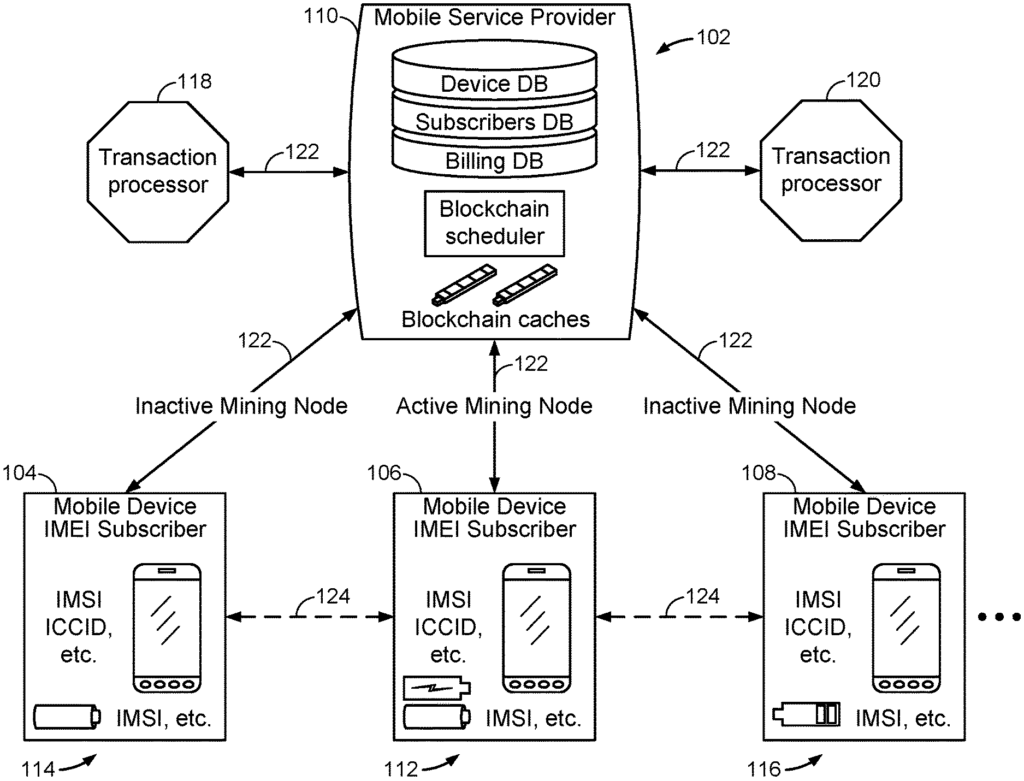
The ARM Ltd invention works as follows
Briefly,” “Example methods, apparatuses and/or articles are disclosed which may be implemented in whole or part using one or multiple mobile communication devices or processing devices in order to facilitate and/or assist one or several operations and/or technologies for blockchain mining using trust nodes. For example, via the democratization associated resources for fair Blockchain mining.
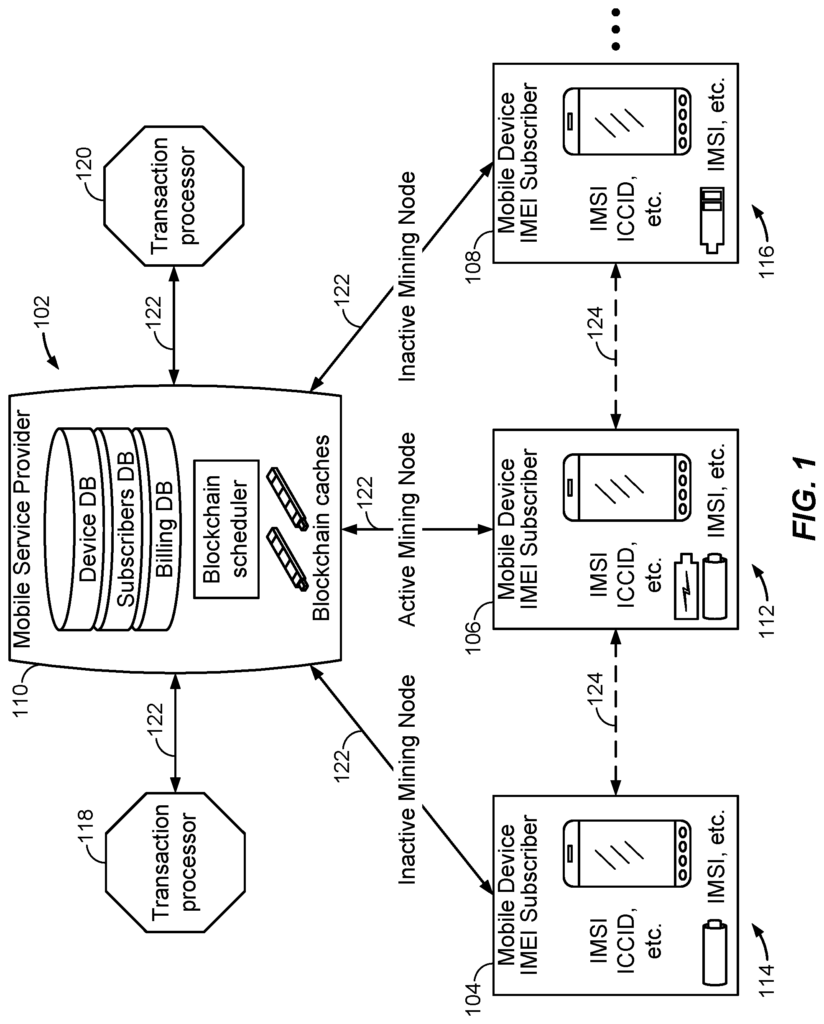
Background for Blockchain Mining using Trusted Nodes
1. Field
The present disclosure is a general description of blockchain infrastructure, and more specifically, blockchain mining using trusted nodes.
2. Information
A blockchain can be a data structure or content that contains a series of back-linked, serially-ordered blocks of online transactions. A block can be a data or content container that contains a list of online transactions, references, and links. Back?to the previous block of a chain. Also called a “parent” Block, using a digital fingerprint or block “hash” of the previous block. In a blockchain each block has a hash from its parent block. This allows the blocks to be linked via a series of hashes, all the way back to the first block. block. A block’s current hash affects the hash of a previous block in a Blockchain. Therefore, changing or modifiying a parent’s block will modify the hash for its child’s. In turn, modifying or changing a block in a child’s block will modify the hash of its grandchild’s blocks and so on. This structure could, for instance, make it difficult to modify a block once there are a sufficient number of blocks in the next generation or subsequent blocks. At least partly, this is due to a costly effort that involves re-computations all previous blocks. If a block is modified in a blockchain, subsequent blocks will have to be recomputed at considerable cost. Older blocks become more secure and accepted as transaction history.
In some cases, a network node known as a mining or “miner” may validate transactions in a block. By finding the correct solution to a math problem or puzzle, for example, by repeating cryptographic hashing. A miner who has solved a mathematical puzzle may receive a reward or fee, and record their validated block of online transactions into a blockchain. A validated block can be confirmed or verified by other miners to ensure it complies to consensus rules. Network-wide, or otherwise. A miner can compete with others on a network to solve a puzzle. For example, they may try to generate fixed-length hashes, by trying repeatedly to change the output of a ish an extremely large number of time, until it matches a specific requirement. A miner can expend significant processing, electrical power and/or computing effort to achieve this.
In this high-intensity computer environment, with increasingly difficult blockchain puzzles and hashing hardware, the likelihood that a miner will be able to find a solution more efficiently or effectively is very small. In this way, the blockchain incentive system encourages miners adopting more efficient technology to keep up with the escalating difficulty in mining each new block generation, and indirectly, to jockey to monopolize earnings by using continuously improved mining technologies. To make mining sustainable or profitable, today’s miners can use ASICs with a high hashing capacity, like graphic processing units (GPUs), FGPAs, etc. In the past, ASICs were used. Mining has therefore become a business that has significant capital costs. As well as operational costs (electricity and monitoring personnel). ASIC miners may gain an unfair advantage over other network members if they are geographically located near lower-cost electrical power or cooler climates. For example, miners may have an unfair advantage on other network members. In order to avoid this, mining blockchains has been concentrated in certain geographic areas. The mining of blockchain has become increasingly concentrated in certain geographic areas, such as cooler (e.g. mountainous, etc.). Hydropower is a good example of a cheaper or more accessible hydropower.
In certain instances, the ability of competing for a lesser reward over time, such as a decreasing blockchain reward structure and/or an exponential increase in mining difficulties, may lead to rapid escalation in more powerful hardware, in fewer hands or in particular geographical areas. It may disrupt a consensus mechanism on a blockchain, lead to a decrease in the security of blockchain protocols, have international trust implications and/or be a cause for concern, etc. and ultimately result in a failure of the blockchain mining market. As an example, a blockchain that was thought to be safe due to its length (as discussed above) may be undone if a group or miners with a large share of the mining power create a longer chain. This would reverse previous blocks. In some cases, the security of a Blockchain may depend on knowing that miners are bound and/or have trusted computational capabilities, to detect and/or guard against selfish mining attacks. In some cases, the current blockchain infrastructure is not able to determine or measure trustworthiness in mining nodes. For example, in terms of their computing capability.
References in this specification to one or more implementations, embodiments, embodiments, etc., mean that the feature, structure, characteristic and/or other characteristics described in relation with a specific implementation and/or implementation are included in at lease one implementation and/or implementation of the claimed subject matter. The appearance of these phrases in different places within this specification does not mean that they refer to the exact same implementation or embodiment, nor to any particular implementation or embodiment. It is also important to understand that certain features, structures and characteristics described can be combined in different ways in an implementation or embodiment. This, in turn, falls within the intended claim scope. As has always been true for the specification in a patent application these and other issues can vary depending on the context of use. In other words throughout the disclosure, contexts of description or usage provide helpful guidance on reasonable inferences that can be drawn. However, similarly, “in this context?” “In general, without any further qualification, refers to at least the context of the current patent application.
Some examples of methods, apparatuses and/or articles are disclosed in this document that may be used in whole or part to facilitate and/or provide support for one or more operations or techniques for blockchain mining utilizing trusted nodes. For example, via democratization associated resources for fair Blockchain mining. As will be shown, in certain instances, participants who provide blockchain mining services can benefit from incentive plans which may be dynamically adjusted to reflect the value of resources participants may contribute. In this context, “fair” is important. ?fairness,? In relation to blockchain mining, the term “fairness” or similar terms refers to a principle that allows miners to track rewards available at a particular time. For example, a blockchain mining procedure can honor these services and/or incentive consistently and equitably. In some cases, as discussed further below, one or more of these operations or techniques can be implemented in or with mobile communication devices, either in full or in part. As used herein, ?mobile device,? ?mobile communication device,? ?location-aware mobile device,? Similar terms can be used interchangeably to refer to any special purpose computing platform, apparatus or device that has a location or position that may change from time to time. Mobile communication devices may be able to estimate their location by using appropriate techniques, and/or communicate with other mobile or non-mobile devices through wireless transmission of information in accordance with one or several communication protocols. “As an example, special-purpose mobile communication devices (also called mobile devices) may include, among others, cellular phones, smart phones, laptop computers, personal entertainment devices, tablet PCs (PCs), personal audio and video devices (PAV), navigation systems (PCs), etc. or any other device that can be identified or authenticated using one or more wireless communication protocols.
In this context, Blockchain mining? “Blockchain?mining” or simply’mining’ The process of validating an online block of transactions by a mining network or “miner” is called’mining. For example, if you solve a puzzle or problem on a blockchain to qualify for inclusion, the miner or mining node may receive a reward or fee. The terms “mining node” and “miner” are used in this document. The terms’mining node’ and’miner” can be used interchangeably. They refer to a network node capable of solving a blockchain problem or puzzle via one or more cryptographic hashing operations, such as using a proof-of-work type process. The terms’miner’ and?miner? can be used interchangeably to refer to a node of a network capable of solving a puzzle or problem in a blockchain using one or more cryptographic operations. The claimed subject matter does not have to be limited to one particular method or approach. In some cases, a process or approach based on a “proof-of-stake” may be employed, either in full or in part. For instance, an escrow fund for a specific miner or the imposition of disincentives in order to reduce or prevent improper behavior by a miner, could be used. Even though a consensus-based process or method is described here, for example, it may be used in conjunction with or instead of a proof of work-type approach or process. To solve a puzzle on a blockchain, a miner may repeatedly hash the header of a block, such as by changing a parameter at the end of its hash. This is called a?once? The hash is repeated until it meets a certain criteria. This can be a number that is less or equal to a target value (e.g. a hash value of the block header). Some cryptographic hashing processes, such as double-SHA256 or SHA256, may be performed at least partially using a SHA256 type process. The claimed subject matter does not limit itself to a target containing a 256 bit number in hexadecimal. Other suitable cryptographic hashing algorithms are also known (e.g. Scrypt, Blake256, CryptoNight, HEFTY1, SHA-3, scrypt jane, scrypt n, etc.). Alternatively, and/or later developed can also be used, in full or part.
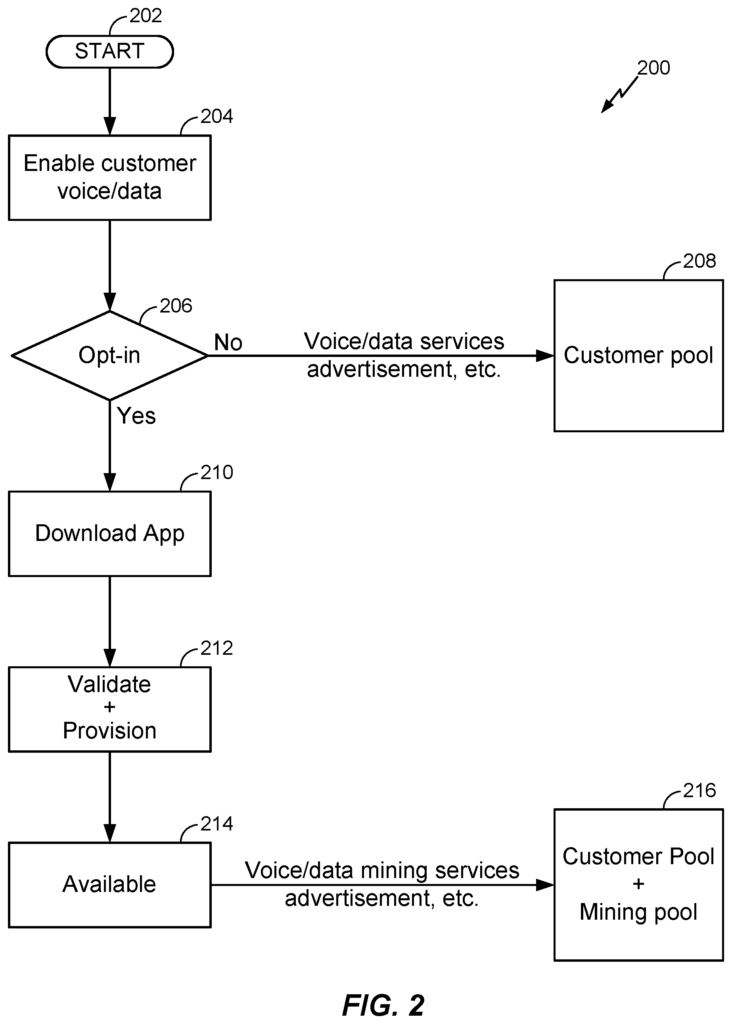
An ?on-line transaction? “An?on-line transaction? Refers to an electronic or online event, such as a communication, agreement or recording. A transaction can be a transfer or asset, like a cryptographic coin, a confirmation of identity, etc. A transaction can be signed using any digital signature suitable, including a public or private key or any combination of these. A transaction can refer to a previous output as a new transaction input. It may also assign input values for the new output. A transaction can be encrypted or not. As used herein, ?on-line? As used herein,?on-line? refers to the type of communication that can be implemented electronically. For example, via one or several suitable communications networks, such as wireless, wired etc. For example, “It should be understood that these examples are only examples of an online transaction or a transaction. The claimed subject matter does not limit itself to this.
?Content,? as the term used herein, should be interpreted broadly and refers to signals, such signal packets, for example, and/or states, such as physical states on a memory device, for example, but otherwise is employed in a manner irrespective of format, such as any expression, representation, realization, and/or communication, for example. Content may comprise, for example, any information, knowledge, and/or experience, such as, again, in the form of signals and/or states, physical or otherwise. In this context, ?electronic? or ?on-line content? refers to content in a form that although not necessarily capable of being perceived by a human, (e.g., via human senses, etc.) may nonetheless be transformed into a form capable of being so perceived, such as visually, haptically, and/or audibly, for example. Non-limiting examples may include text, audio, images, video, combinations, or the like. Thus, content may be stored and/or transmitted electronically, such as before or after being perceived by human senses. In general, it may be understood that electronic and/or on-line content may be intended to be referenced in a particular discussion, although in the particular context, the term ?content? may be employed for ease of discussion. Specific examples of content may include, for example, an e-mail message, text message, audio file, video file, web page, or the like. Claimed subject matter is not intended to be limited to these particular examples, of course.
As was indicated, one or more network nodes may comprise, for example, one or more mining nodes capable of finding a valid proof of work for new blocks via repeated cryptographic hashing operations. Depending on an implementation, a mining node may comprise, for example, a full node, a lightweight node, or any combination thereof. In this context, a ?full node? refers to a network node capable of facilitating and/or supporting all or most processes for blockchain mining. For example, a full node may be capable of finding a valid proof of work, network routing, providing wallet services, maintaining a full copy of a blockchain in its memory, verify and/or propagate transactions, enforce consensus rules, or the like. A ?lightweight node,? as the term used herein, refers to any mining node other than a full node. For example, a lightweight node may be capable of finding a valid proof of work for a block of on-line transactions and/or communicating block-related updates for inclusion in a blockchain, but may not be capable of maintaining a full copy of a blockchain in its memory, such as due, at least in part, to memory constraints, as one possible example. Thus, in some instances, a lightweight node may, for example, rely on one or more other nodes (e.g., other lightweight nodes, full nodes, server devices on a network, etc. ), such as for transaction verifications, block validations, etc. One particular example of a lightweight node may include a simplified payment verification (SPV) node capable of downloading block headers, rather than full blocks, for example, for a blockchain. Claimed subject matter is not so limited, of course.
As previously mentioned, the security of blockchain can be compromised or affected by, for instance, a geographically-localized group of miners who control a majority of computing resources. This could happen, for example, through cheaper power or superior mining technology. These or similar geographic concentrations may, in some cases, also affect or impact blockchain’s safety due, at least partly, to network related?bottlenecks? Since a blockchain protocol does not verify the identity of the nodes or their computational power, it can be vulnerable to selfish mining attacks. In some cases, a blockchain can be used in conjunction with or as part of a service that is suitable (e.g. for processing banking transactions). As discussed in the following section, this could, for instance, be a problem in certain instances. In the banking, financial or similar sectors, for example, it may not be prudent or desirable to allow unknown or untrusted parties validate transactions such as payments or remittances. The performance of blockchain infrastructure can also be affected by network-related scaling, such as when a larger number of miners is required to validate transactions. As an example, a more “fragile” network may not be able to keep a larger number of mining nodes online (e.g., operational etc.). For example, less scalable or?fragile’ networks might not be able to keep more mining nodes online (e.g. operational, etc.). It may be difficult to find a solution in certain cases if the network is not scalable enough.
To address these issues or similar ones, banks, financial services, or other like-minded organizations may use private blockchains. These blockchains are of limited utility, but can be used for interbank transfers. For example, a trusted bank could participate by using trusted hardware, adding blocks to the collective blockchain, and keeping miners selected, secure, and/or small in numbers. This approach may not fully take advantage of the decentralized or distributed nature of the blockchain infrastructure. For example, it is possible that this approach does not go beyond the cloud-like models of being able dynamically distribute the load amongst many parties and/or tracking the costs. It was mentioned that, in some cases, the security of a chain can be increased by a greater number of authenticated platforms with known capacities. It may therefore be desirable to develop methods, systems and/or devices that can generate and/or incorporate trusted blockchain infrastructure into an operations support system or similar computing platform of a provider. For example, to implement mining of blockchains in a large-scale controlled computing environment. This may include, for instance, a global network of nodes with proven computational capability.
So, as described below in more detail, an implementation may, for example validate one or several blocks of online transactions, by finding valid proofs of work using idle cycles on processing units of mobile devices connected to the network and registered with one or multiple mobile service providers (MSPs). Mobile device records can be used to at least partially address issues such as lack of trustworthiness, or similar issues, by using unique identities that are indicative of the computational capabilities of mobile devices. More specifically, based at least in part on one or two identifiers such as an International Mobile Equipment Identity(IMEI), International Mobile Subscriber Identity(IMSI) or the like, a MSP could be able to certify computational capabilities of their mobile devices, and/or prove that a mobile device isn’t an ASIC-accelerated miner with an unfair edge.
As discussed further below, the charging cycles of mobile devices participating in the network may be extended, such as during nighttime when a network is not being used. This can then be used in whole or part to find valid proof of work and communicate updates to a Blockchain, among other processes. In some cases, the use of trusted nodes for mining blockchains can provide benefits, such as allowing a service provider, among other things, to offer one, or several blockchain-related services in exchange for a fee or reward. At times, the use of trusted mining entities can also help to prevent rapid increases in miner capacity. In the event of an end to Moore’s Law, a Nakamoto model of increasing difficulty could become problematic, since it may not always reflect hardware advancements. “As was also mentioned previously, one or several approaches discussed in this paper may result in a more controlled and/or predictable blockchain infrastructure.
FIG. The schematic diagram 1 illustrates features of an implementation of a use case or scenario for an operating environment 100. This may be used in part or whole to facilitate or support one or more operations or techniques for mining blockchains using trusted nodes. In some cases, as indicated above, an example operating environment 100 can be used, either in full or in part, to implement a blockchain service offered by a mobile services provider (MSP), referred to generally with the arrow at 102. MSP 102, as seen, may have a plurality mobile devices that subscribe to its services, referred to generally by 104, 106 and 108. These devices could be registered on the network of MSP 102 via one or multiple unique identifiers. Note that even though only a limited number of devices, networks systems, databases features, links etc. are shown, any other suitable devices, networks, system, databases, feature, link, etc. can be used. It should be noted that, even though a certain number of particular devices, networks systems, databases features, links etc. Herein, various implementations are possible. In some cases, service providers might join forces, collaborate etc. So as to provide and/or offer mobile and/or Blockchain services in multiple jurisdictions and even globally. Mobile service providers, for example, may cooperate around the world to offer a global service during a period of time when a large population is charging their phones or inactive. A single or double-sided arrow may also, depending on the implementation, be used to indicate unidirectional or bidirectional flow or any combination of these, as well as in relation to signals, communications, processes, operations and/or other things that can comprise or be represented by one or more digital signal. In certain instances, the example operating environment 100 can be implemented either in an indoor or outdoor environment. Note that example operating environments 100 are not limited to a single service provider such as MSP 102. “Any other service provider that is suitable, such as a money transfer service or an online marketplace, ecommerce service or financial service can implement one or more of the operations or processes described herein in full or in part.
According to an implementation, the user of a device such as a mobile 104,106,108 etc., can join a community of wireless subscribers. For example, a user may be offered the option to join a wireless community, via an opt-in function discussed below, in order to contribute idle cycles from corresponding mobile devices for mining blocks of online transactions. Sometimes, an idle cycle can be generated by mobile devices 104,106,108 etc. As an example, a mobile device 104, 106, 108, etc. may contribute when it finishes its normal charging cycle. A user who opts in may share and/or receive a reward or fee from MSP 102 as part of the blockchain mining process. For example, if a mobile mining node mines a certain block successfully. A reward or fee can be any reward and/or fees, including, for example, non-monetary rewards, transaction fees, etc. MSP 102, for example, may decide as part of a customer service agreement that a reward or fee can be in the form of a coupon, rebate on a subscriber?s billing agreement and/or their phone lease agreement, or any other reward and/or fees (e.g. digital currency, fee to validate transactions, etc.). The subject matter of the claim is not limited. In some cases, for example, the form, amount or other factors may be included. A reward or fee can be set, at least partially, by another party (e.g. a bank) Or a combination thereof.
As shown, in an example, unlike typical Blockchain infrastructure, MSP 102 can comprise, for instance, an OSS (referenced as 110), which may include or be associated with one of more databases or similar repositories containing one or multiple records of mobile devices 104 106 108 etc. One or more records could, for example, contain standardized identifiers or keys such as the International Mobile Subscriber Identity, an Integrated Circuit Card Identity, an International Mobile Equipment Identity, a Mobile Station Integrated Services for Digital Network Number (MSISDN), and so on. MSP 102 can, as indicated, identify subscribing subscribers, types, brands, models, etc., by using these records or similar ones. of mobile devices 104, 106, 108, etc. As such, they may be able to assess and/or prove their computational capability and/or the bounded computing capacity of an associated networks. In certain instances, unique identifiers or similar ones may be used at least partially for billing, as in the case of MSP 102. Wireless communication protocols (e.g. 3GPP, etc.) Assure that the device is authenticated by a user to be able transmit and receive data. These or similar communications may be more secure with this authentication (e.g. in the sense that they can be attributed to a specific source etc.). Standard IP (without a VPN, IPsec, etc.) This ‘authentic authentication’ is a good example. This may increase the security of miners who are associated. As such, network-connected mobile devices 104, 106, 108, etc. The computational pool may include trusted blockchain infrastructure to enable more effective and/or efficient mining of blockchains, for instance, by increasing the hashing rate. As shown, OSS 110 can include, for instance, one or multiple databases that contain billing information, account amounts, reward balances and/or fee amounts.
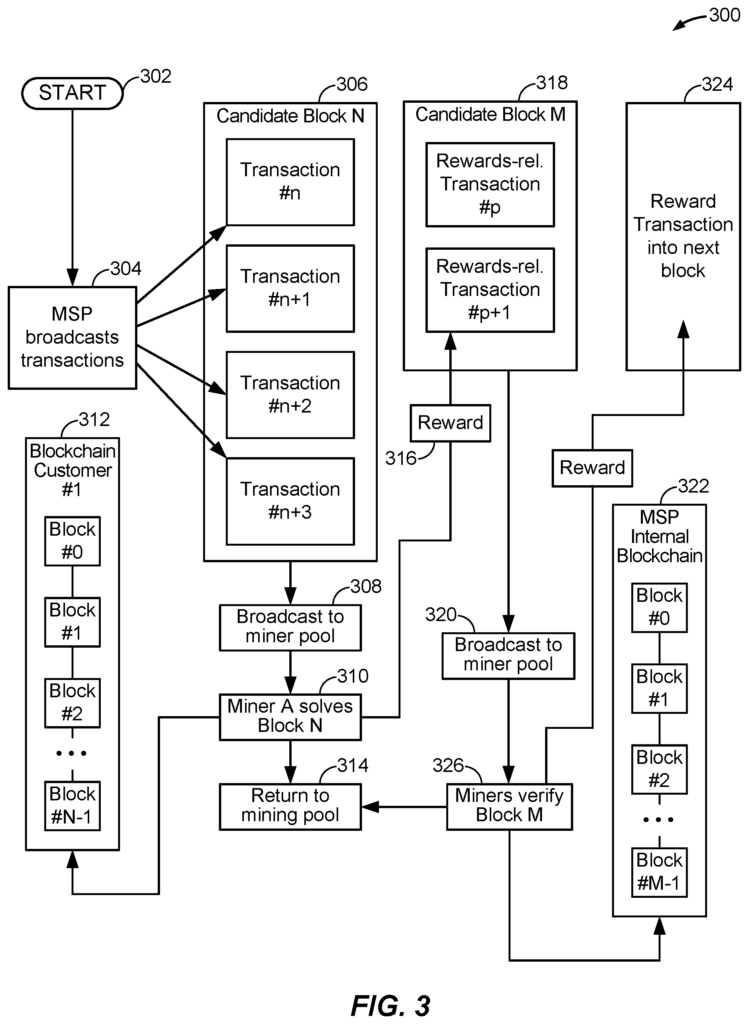
As indicated, but not shown, the example operating environment may include, for example any other type or number of computing devices, platforms, and/or software capable of supporting and/or facilitating one or more operations, techniques, and/or methods for blockchain mining utilizing trusted nodes. Depending on the implementation, an example operating environment may include one or more servers, processing units and gateways, base transceiver station, access points and/or other devices. In certain instances, the example operating system 100 may include, for instance, one or multiple location servers for estimating the locations of mobile devices such as 104,106,108 etc. Using one or more techniques. Location determination may be done via GPS, WiFi, radio heat maps, or other techniques. These techniques are well-known and do not need to be explained in detail. Here, unlike typical (e.g. pseudo-anonymous etc.) Blockchain infrastructure allows the location of mobile devices to be used in at least part for government mandated regulations, taxation and financial reporting.
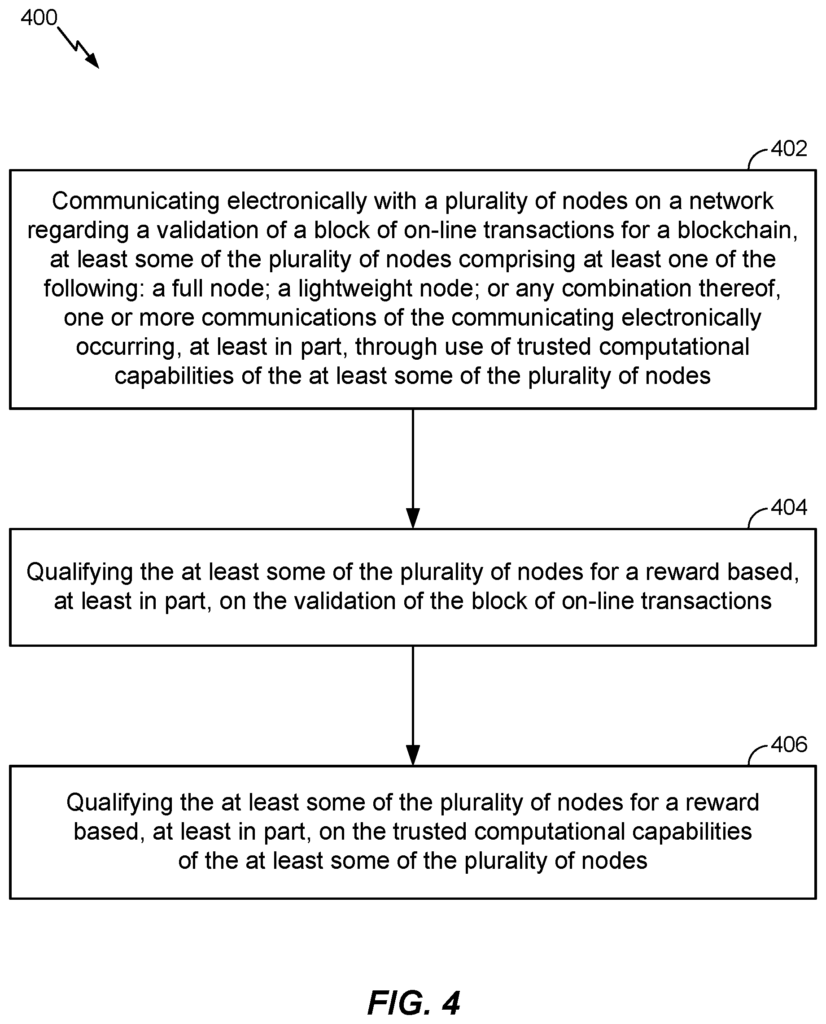
Click here to view the patent on Google Patents.
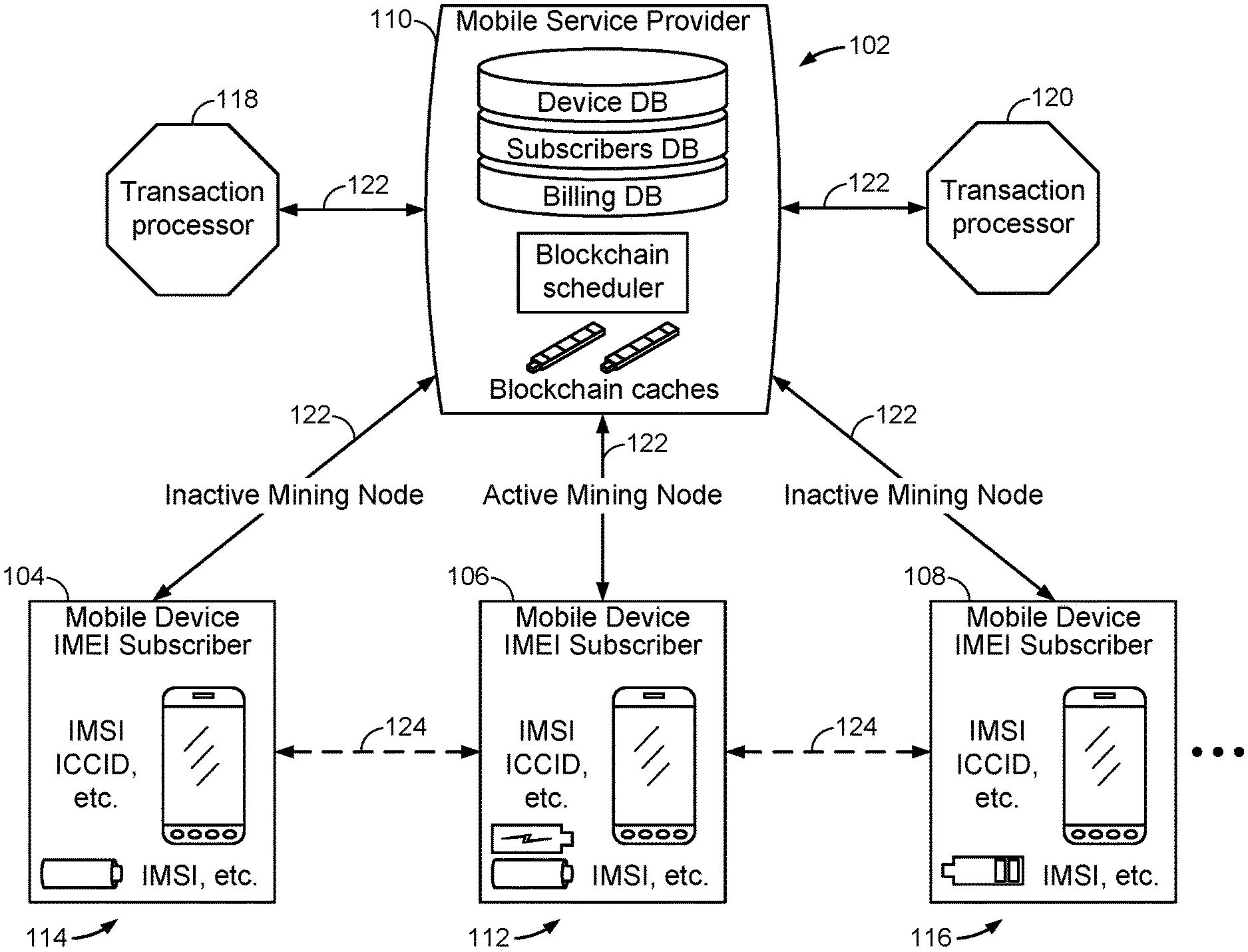
Leave a Reply